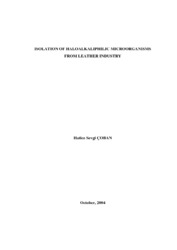Please use this identifier to cite or link to this item:
https://hdl.handle.net/11147/3251Full metadata record
| DC Field | Value | Language |
|---|---|---|
| dc.contributor.advisor | Yenidünya, A.Fazil | en |
| dc.contributor.author | Çoban, Hatice Sevgi | - |
| dc.date.accessioned | 2014-07-22T13:51:11Z | |
| dc.date.available | 2014-07-22T13:51:11Z | |
| dc.date.issued | 2004 | en |
| dc.identifier.uri | http://hdl.handle.net/11147/3251 | |
| dc.description | Thesis (Master)--İzmir Institute of Technology, Biology, İzmir, 2004 | en |
| dc.description | Includes bibliographical references (leaves: 43-49) | en |
| dc.description | Text in English; Abstract: Turkish and English | en |
| dc.description | xiii, 68 leaves | en |
| dc.description.abstract | Haloalkalophiles are extremophilic microorganisms that are adapted to saline and alkaline conditions. Different species of them have been isolated so far from soda lakes and soil samples. Haloalkalophilic microorganisms have significant adaptive mechanisms to avoid denaturing effect of salts and to balance their interior pH. Extracellular enzymes that are produced by these halophilic and alkalophilic microorganism are applicable for industrial purposes. Therefore isolation of these organisms from their habitats and study on genotypic characterization constitute initial steps for furter biotechnological studies. In this study, processing steps of leather factories and their wastewater were chosen for sampling. In order to isolate target microorganisms Horikoshi-I medium including 12% NaCl was used. After isolation microorganisms were purified. Phenotypic tests were applied (Gram staining, catalase and oxidase behaviors, spore observation by phase contrast microscope, sensitivity to antibiotics and extracellular enzyme screenings). For genotypic characterization, genomic DNA was isolated and 16S-ITS rDNA region was amplified. Differentiation was achieved according to Restriction Fragment Length Polymorphism (RFLP) method by using Hae III and Taq I endonucleases. Isolates, which represented the different RFLP patterns, were chosen for building up the haplotype groups. As a result of the study seven different RFLP haplotypes were identified.Moreover, 16S ribosomal DNA partial sequencing was also performed on some of the strains in. These haloalkalophilic microorganisms and their enzymes could be used in different biotechnological studies in the future for various industrial applications. | en |
| dc.language.iso | en | en_US |
| dc.publisher | İzmir Institute of Technology | en |
| dc.publisher | Izmir Institute of Technology | en_US |
| dc.rights | info:eu-repo/semantics/openAccess | en_US |
| dc.subject.lcc | QR97.S3 .C65 2004 | en |
| dc.subject.lcsh | Halophilic microorganisms | en |
| dc.subject.lcsh | Alkalophilic microorganisms | en |
| dc.title | Isolation of haloalkaliphilic microorganisms from leather industry | en_US |
| dc.type | Master Thesis | en_US |
| dc.institutionauthor | Çoban, Hatice Sevgi | - |
| dc.department | Thesis (Master)--İzmir Institute of Technology, Molecular Biology and Genetics | en_US |
| dc.relation.publicationcategory | Tez | en_US |
| item.grantfulltext | open | - |
| item.openairetype | Master Thesis | - |
| item.fulltext | With Fulltext | - |
| item.cerifentitytype | Publications | - |
| item.openairecristype | http://purl.org/coar/resource_type/c_18cf | - |
| item.languageiso639-1 | en | - |
| Appears in Collections: | Master Degree / Yüksek Lisans Tezleri | |
Files in This Item:
| File | Description | Size | Format | |
|---|---|---|---|---|
| T000495.pdf | MasterThesis | 3.76 MB | Adobe PDF |  View/Open |
CORE Recommender
Page view(s)
116
checked on Apr 29, 2024
Download(s)
106
checked on Apr 29, 2024
Google ScholarTM
Check
Items in GCRIS Repository are protected by copyright, with all rights reserved, unless otherwise indicated.